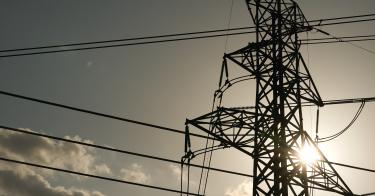The U.S. power grid is already straining under excess regulations, with blackouts possible, but now the U.S. Environmental Protection Agency (EPA) has proposed two more rules that promise to cause even more major problems.
One is a tailpipe emissions standard that would require 60% of new cars sold in 2030 to be electric. The other is a rule that would force hundreds of power plants to shut down.
The unintended consequences of these rules are obscured by the flawed assumptions the EPA uses in assessing the effects they’ll have on grid reliability and cost. People simply cannot make informed decisions about EPA regulations—like choosing whether to support or oppose them—when the assessments don’t reflect reality.
The new tailpipe emissions standard is so strict that it requires most new passenger vehicles sold to be electric vehicles (EVs) by 2030. It is a de facto EV mandate that will saddle the nation’s power grid with much more demand (here are the public comments I provided the EPA on this proposed rule).
The emissions standard for power plants has been called the Clean Power Plan 2.0 because it is EPA’s second attempt to redesign the power sector (the first try was rejected by the Supreme Court). The Clean Power Plan 2.0 is so strict that the only realistic way for many plants to comply is to shut down. It is another de facto mandate—particularly mandating the closure of existing coal-fired power plants—that will cause a sharp decrease in the supply available to the U.S. power grid (comments on this rule are due to EPA on Aug. 8 and can be submitted here).
>>> Supreme Court Ruling Makes Waves for Biden’s EPA
The legal problems surrounding these rules are many, but let’s assume for a moment that the Supreme Court upholds them. Are they good policy? What will happen if they go into effect?
The EPA says neither rule will cause reliability problems or increase prices. One tactic the agency uses to reach these conclusions is to ignore its other rules (for example, to ignore the power plant rule when analyzing the effects of the tailpipe rule). According to the EPA, the increase in electricity demand from the EV mandate doesn’t conflict with the severe reduction in supply from the power plant rule; they simply assume the companion rules don’t exist.
The agency then dodges questions about electric reliability by assuming EV charging will only occur when it’s convenient for the power grid. As we see in California, that is simply untrue—people will charge their EV whenever they want, and many will ignore calls for voluntary conservation during the highest-stress hours on the grid. Such conservation calls are named “flex alerts” in California and have become commonplace during the summer months.
Texas also faces tight grid conditions. The Electric Reliability Council of Texas recently set up a California-style alert program—called the Texas Advisory and Notification System—to discourage electricity use when the power grid is stressed, which seems to happen more and more. Notably, California and Texas are both big on EVs. Among the three leading EV states, the one that doesn’t regularly call for conservation is Florida. But that may have more to do with Florida’s reluctance to force renewables onto its system and close existing power plants, unlike California and Texas.
The importance of reliable supply brings us to EPA’s power plant rule. The Clean Power Plan 2.0 makes it legally impossible to continue operating coal-fired power plants, which contribute about 20% of electricity generation, and represent about 25% of the reliable capacity on the U.S. electric grid. The rule superficially offers three solutions—coal plant owners can use “green” hydrogen (hydrogen electrolyzed by renewables), capture nearly all carbon dioxide emissions, or shut down—but only the last option is truly viable.
Given previous regulatory gamesmanship at the EPA, many see the Clean Power Plan 2.0 as a cynical play to scare owners of coal plants to close, whether or not the rule survives court challenge. The unanimous opinion of the four members of the nation’s independent agency in charge of grid reliability (the Federal Energy Regulatory Commission) is that coal-fired power plants are essential for grid reliability.
The rule also applies to existing natural gas plants, despite their lower carbon footprint compared to coal plants, and despite resistance from the EPA that the White House plan over-reached into the existing natural gas sector. Perhaps the agency knows better than the White House that—despite billions in subsidies for renewables—natural gas-fired generation is still growing in Texas and is holding strong in green-tinted California, above 40% of the electricity mix and even hitting 60% of all generation during last summer’s heat wave.
>>> Biden’s Executive Overreach Kills American Energy Independence
That is because intermittent renewables like wind and solar need a more reliable source like gas to satisfy demand when they cannot, which is most of the time.
Regarding cost, the EPA’s denial of reality hits new heights. The agency estimates that the EV mandate could in fact reduce electricity prices in some areas. This is implausible because EVs represent a large new demand on the power grid, and we know they cause utilities to invest heavily in local distribution systems, especially when multiple homes plug EVs into the same radial power line.
A Princeton study analyzing a “net zero by 2050” scenario found that, of the staggering $2.5 trillion in spending needed in the 2020s in a high electrification case, over $1.4 trillion would be needed to support the expansion of electricity generation, transmission, and distribution networks and on EVs and charging stations. California alone may spend $50 billion by 2035 to accommodate new electrification of products such as EVs.
The EPA denies that these costs exist. Once again, agency officials selectively assume that transmission and distribution costs won’t change from the no-policy baseline, a ridiculous assumption that should get the rule thrown out.
When it comes to EPA regulations, buyer beware. The price tags in its regulatory impact analyses are unconnected to reality, and even the most predictable grid reliability problems have been swept under the rug.
This is no way to sell a transition to the American people. The EPA should go back to the drawing board and return with a set of honest assessments.
This piece originally appeared in RealClear Energy


